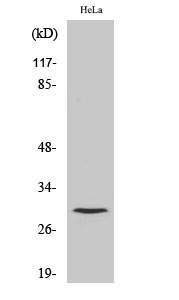Cleaved-Cathepsin L1 HC (T288) Polyclonal Antibody
- Catalog No.:YC0041
- Applications:WB;ELISA
- Reactivity:Human;Rat;Mouse;
- Target:
- Cathepsin L
- Fields:
- >>Autophagy - animal;>>Lysosome;>>Phagosome;>>Apoptosis;>>Antigen processing and presentation;>>Proteoglycans in cancer;>>Rheumatoid arthritis;>>Fluid shear stress and atherosclerosis
- Gene Name:
- CTSL1
- Protein Name:
- Cathepsin L1
- Human Gene Id:
- 1514
- Human Swiss Prot No:
- P07711
- Mouse Swiss Prot No:
- P06797
- Immunogen:
- The antiserum was produced against synthesized peptide derived from human CATL1. AA range:239-288
- Specificity:
- Cleaved-Cathepsin L1 HC (T288) Polyclonal Antibody detects endogenous levels of fragment of activated Cathepsin L1 HC protein resulting from cleavage adjacent to T288.
- Formulation:
- Liquid in PBS containing 50% glycerol, 0.5% BSA and 0.02% sodium azide.
- Source:
- Polyclonal, Rabbit,IgG
- Dilution:
- WB 1:500 - 1:2000. ELISA: 1:10000. Not yet tested in other applications.
- Purification:
- The antibody was affinity-purified from rabbit antiserum by affinity-chromatography using epitope-specific immunogen.
- Concentration:
- 1 mg/ml
- Storage Stability:
- -15°C to -25°C/1 year(Do not lower than -25°C)
- Other Name:
- CTSL1;CTSL;Cathepsin L1;Major excreted protein;MEP
- Observed Band(KD):
- 30kD
- Background:
- The protein encoded by this gene is a lysosomal cysteine proteinase that plays a major role in intracellular protein catabolism. Its substrates include collagen and elastin, as well as alpha-1 protease inhibitor, a major controlling element of neutrophil elastase activity. The encoded protein has been implicated in several pathologic processes, including myofibril necrosis in myopathies and in myocardial ischemia, and in the renal tubular response to proteinuria. This protein, which is a member of the peptidase C1 family, is a dimer composed of disulfide-linked heavy and light chains, both produced from a single protein precursor. Multiple alternatively spliced transcript variants have been found for this gene. [provided by RefSeq, Apr 2012],
- Function:
- catalytic activity:Specificity close to that of papain. As compared to cathepsin B, cathepsin L exhibits higher activity toward protein substrates, but has little activity on Z-Arg-Arg-NHMec, and no peptidyl-dipeptidase activity.,function:Important for the overall degradation of proteins in lysosomes.,similarity:Belongs to the peptidase C1 family.,subunit:Dimer of a heavy and a light chain linked by disulfide bonds.,
- Subcellular Location:
- Lysosome . Apical cell membrane ; Peripheral membrane protein ; Extracellular side . Cytoplasmic vesicle, secretory vesicle, chromaffin granule . Secreted, extracellular space . Secreted . Localizes to the apical membrane of thyroid epithelial cells. Released at extracellular space by activated dendritic cells and macrophages. .; [Isoform 2]: Nucleus . Translation initiation at downstream start sites allows the synthesis of isoforms that are devoid of a signal peptide and do not transit through the endoplasmic reticulum to localize to the nucleus (PubMed:15099520). Nuclear location varies during the cell cycle, with higher levels during S phase (PubMed:15099520). .
- Expression:
- Cartilage,Colon endothelium,Liver,Plasma,Prostate,
- June 19-2018
- WESTERN IMMUNOBLOTTING PROTOCOL
- June 19-2018
- IMMUNOHISTOCHEMISTRY-PARAFFIN PROTOCOL
- June 19-2018
- IMMUNOFLUORESCENCE PROTOCOL
- September 08-2020
- FLOW-CYTOMEYRT-PROTOCOL
- May 20-2022
- Cell-Based ELISA│解您多样本WB检测之困扰
- July 13-2018
- CELL-BASED-ELISA-PROTOCOL-FOR-ACETYL-PROTEIN
- July 13-2018
- CELL-BASED-ELISA-PROTOCOL-FOR-PHOSPHO-PROTEIN
- July 13-2018
- Antibody-FAQs
- Products Images

- Western Blot analysis of various cells using Cleaved-Cathepsin L1 HC (T288) Polyclonal Antibody



